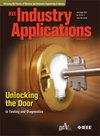Spatio-Temporal and Correlation Modeling of EV Charging Data for Hosting Capacity Analysis
IF 4.5
2区 工程技术
Q2 ENGINEERING, ELECTRICAL & ELECTRONIC
引用次数: 0
Abstract
The growing number of residential Electric vehicles (EVs) are posing a significant challenge for grid operators around the world. This paper presents spatiotemporal (ST) modeling approach to address system uncertainties and copula theory to model correlations of EV charging demand with EV users’ travel parameters (such as EV departure time, trip distance, and EV arrival time) and solar PV generation. Copula theory is employed to represent the correlations between these parameters, validated using the Kolmogorov-Smirnov (KS) test and quantile-quantile (q-q) plots. The case study presents EV hosting capacity in an Australian distribution network, adapting the modeled EV charging demand with real-world measured load demand profiles. The network EV hosting capacity is determined subject to voltage violation risk (VVR), line overloading, and transformer capacity violation. According to the results, the EV hosting capacity was found to be limited to 25% EV penetration due to the transformer capacity limit primarily. However, the EV hosting capacity could reach 50% without violating the VVR limit. The simulation results also indicate that for the chosen test network and load profile, the EV hosting capacity is slightly higher on weekends than on weekdays of the simulation period.面向主机容量分析的电动汽车充电数据时空关联建模
越来越多的家用电动汽车(ev)对世界各地的电网运营商构成了重大挑战。本文提出了解决系统不确定性的时空(ST)建模方法和耦合理论,建立了电动汽车充电需求与电动汽车用户出行参数(如电动汽车出发时间、行程距离和到达时间)和太阳能光伏发电的相关性模型。使用Copula理论来表示这些参数之间的相关性,并使用Kolmogorov-Smirnov (KS)检验和分位数-分位数(q-q)图进行验证。该案例研究展示了澳大利亚配电网络中的电动汽车托管容量,并将建模的电动汽车充电需求与实际测量的负载需求剖面相适应。网络EV承载容量的确定主要考虑电压违例风险、线路过载和变压器容量违例等因素。结果表明,主要受变压器容量限制的影响,电动汽车承载能力被限制在25%以内。但是,在不违反VVR限制的情况下,EV托管容量可以达到50%。仿真结果还表明,对于所选择的测试网络和负载配置,周末EV承载能力略高于模拟时段的工作日。
本文章由计算机程序翻译,如有差异,请以英文原文为准。
求助全文
约1分钟内获得全文
求助全文
来源期刊

IEEE Transactions on Industry Applications
工程技术-工程:电子与电气
CiteScore
9.90
自引率
9.10%
发文量
747
审稿时长
3.3 months
期刊介绍:
The scope of the IEEE Transactions on Industry Applications includes all scope items of the IEEE Industry Applications Society, that is, the advancement of the theory and practice of electrical and electronic engineering in the development, design, manufacture, and application of electrical systems, apparatus, devices, and controls to the processes and equipment of industry and commerce; the promotion of safe, reliable, and economic installations; industry leadership in energy conservation and environmental, health, and safety issues; the creation of voluntary engineering standards and recommended practices; and the professional development of its membership.
 求助内容:
求助内容: 应助结果提醒方式:
应助结果提醒方式:


